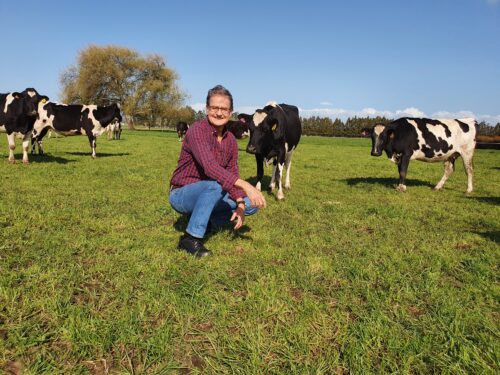Image courtesy of Dr. Caroline Bagshaw
Like those in all animals, the internal biological processes of cattle create byproducts that must be peed, pooped, or (rather notoriously) farted out. Collected waste from the world’s 1.5 billion cows creates a mess for farmers and scientists alike. In addition to the potent greenhouse gases released from their farts, the solid and liquid waste generated by these famously flatulent ruminants can pollute water systems, reduce air quality, and contribute to global warming. Urine contains nitrogen, which is naturally converted into nitrous oxide, a greenhouse gas three-hundred times more powerful than carbon dioxide. Globally, cattle urine accounts for nearly 1.6 percent of greenhouse gas emissions. Scientists from New Zealand and Germany think they may have discovered a solution: toilet-training cows.
Lindsay Matthews, a researcher at the University of Auckland and the science leader, has considered the possibility for a long time. In a 2007 radio interview on the harmful environmental effects of cow waste, the interviewer humorously suggested that Matthews train cows to use the loo. The interviewer, thinking his wacky suggestion would whiz by without much more than a laugh, was shocked to hear that Matthews thought it possible.
Influenced by American behavioral psychologist B.F. Skinner, Matthews and his team developed a backward-chaining—that is, working backwards from the goal—three-step process for training cows.
First, they established a specially constructed latrine as the correct place to “void.” Individual calves were given a diuretic and led into the latrine. Every time a calf urinated, they were rewarded with either a molasses drink or crushed barley—“Ben and Jerry’s [for] cattle,” described Matthews. Training sessions, which lasted for no more than forty-five minutes, were continued until the calves turned to receive the reward after urination eighty percent of the time, or until eight or ten sessions had been completed. At this stage in the training, Matthews and his team were unsure whether they had only conditioned the calves to expect reward upon urination, or whether they had also established the latrine as the correct location for urination.
Next, the calves were allowed to roam freely in a segment outside the latrine. Calves that moved into the latrine to micturate—that’s jargon for urinate—were rewarded, while “accidents” outside the latrine were punished with a three-second water spray. Calves were considered sufficiently trained after three consecutive correct urinations occurred during a session. By the end of the study, eleven of sixteen calves were declared successfully trained.
Finally, a second section was opened leading to the latrine, requiring the calves to control their reflexes over an extended time period and distance. Remarkably, successfully trained calves urinated in the latrine approximately seventy-two percent of the time without any corrective intervention from the experimenters.
Matthews and his team hope that their research findings will be implemented by large and small-scale operations around the world. Matthews acknowledges that there will be some challenges in scaling-up the training, but he is confident that modern technology exists to enable training on a large scale. He suggests that young calves—which are handled frequently and can be kept individually—be monitored and rewarded using machine vision. Maintaining the correct behavior will require careful design and strategic positioning of the latrines, but Matthews is optimistic that “[they] can crack it.”
Matthews suggests that punishment for urination outside may not be required for training. During the training process, some of the calves were successfully trained without the three-second water spray. Of the calves that were punished, most immediately stopped urinating, entered the latrine, and finished their business. “The latent behavior was already there,” Matthews said, “The calves just needed a reminder for it to be correctly expressed.”
The calves are like “kids who know the toilet, [and] know the routine. They just get so distracted,” Matthews said.
He also thinks that training processes that reward for correct behavior inherently punish incorrect behavior: the absence of a reward following incorrect behavior is itself corrective. Matthews and his team will further explore this possibility in the future, as eliminating the punisher will facilitate training on a large scale.
Matthews’ research has demonstrated that these “dopey” ruminants are actually quite intelligent. Through training, they can gain an interoceptive awareness of their urinary systems and learn to control their reflexes—often faster than an infant. And we have a lot to gain when we don’t underestimate cows’ brainpower: capturing eighty percent of cow urine will reduce ammonia emissions by fifty-six percent and significantly reduce the release of nitrous oxide.

